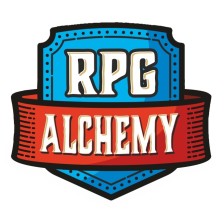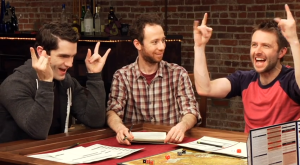Of all the innovations in roleplaying over the years my favorite is the concept of “player-facing” mechanics. For those unfamiliar with the term, player-facing refers to game elements that require the player to roll dice, react, or make decisions instead of the gamemaster. Most every game out there features a majority of player-facing elements such as��attack rolls, skill checks, or saving throws along with several gamemaster-facing elements such as NPC attack rolls and damage rolls.
These days there are a variety of RPG’s on the market that expand on this concept and shift all of the mechanics over to the players’ side of the table. Games like Monte Cook’s Numenera and Wyrd Games’ Through the Breach, have players making all of the dice rolls (or card flips in the case of Through the Breach).��Like most games when a character attacks the player makes an attack roll, but in these games, instead of the gamemaster making an attack roll for the NPC’s the player makes a defensive roll to avoid damage. If they fail the defensive roll the player rolls the damage dice. Many games already have something like this in part of their system; Dungeons & Dragons for example has the saving throw. The saving throw assumes the NPC’s attack works (say a fireball spell), but makes the character roll to see if they can avoid some, or all of the damage.
As a gamemaster player-facing mechanics have drastically improved the gaming experience at my table in two important ways:
1: The Players Feel More Empowered
When a player rolls dice, that player (and their character) ��becomes the active element at the table. The attention immediately shifts to the player rolling dice as everyone pauses��for the crucial moment when the die stops and the story, for good or ill, drives forward. The same general thing might happen when the gamemaster rolls the dice but the energy at the table is completely different. Whenever the gamemaster picks up dice the momentum of the scene shifts to the NPC’s, but when the players are acting and reacting the energy and momentum of the story are on their side of the gamemaster screen. The players are the “active elements”, making decisions and driving their fate forward. When that energy shifts to the gamemaster the players become “passive elements”, they lose the power to do anything other than accept whatever results the gamemaster rolls. Keeping the energy with the players makes the scene more dynamic and the spotlight on the heroes.
If you were a non-playing observer of an RPG using nothing but player-facing mechanics you would remain focused on the heroes; Will the fighter hit the goblin? Can the rogue��survive the specter’s deadly touch? Will the cleric heal the warrior in time? Which of the heroes will survive the dragon’s fiery breath? Your attention is on what the heroes are doing and that is exactly where your attention should be, on the heroes! You’re not asking yourself if the ghoul will hit the noble paladin, but if the paladin can avoid the foul creature’s touch. On the surface this may seem like the same thing, but the subtle shift in perspective keeps the focus on the action and the heroes. It’s the difference between watching the referee at a sporting event and watching the athletes! Keep the focus, and the spotlight, where it belongs, on the heroes.
2: The Gamemaster Feels More Empowered
Keeping the focus on the heroes and using player-facing mechanics allows the gamemaster to act willfully and with intention. As the gamemaster you are not thinking in terms of what your monsters and NPC’s are attempting to do, you’re simply telling the players what they are doing. The gamemaster isn’t��wondering if a monster can successfully execute an attack and hoping the dice cooperate, the narrative assumption is that the attack works flawlessly; lets see if the hero can block, dodge, or avoid it! Not only does this keep the energy and focus on the players it also frees up a considerable amount of the gamemaster’s time.
Excellent time management is crucial to the exciting campaign. Even though most gamemasters may take less time with each monster’s turn then a player takes with their character, it still eats up a lot of time for the gamemaster to decide what the NPC is attempting to do, roll the dice to see if they are successful, compare results, and then narrate an outcome. With player-facing games the gamemaster quickly��states what the monsters are doing and the momentum immediately returns to the heroes. The gamemaster can even execute several different NPC attacks and actions all at once instead of doing each thing separately. Imagine an encounter with the heroes and group of goblins. Instead of taking several minutes describing each of the creatures’ actions the gamemaster simply says something like; “The front-line goblins surge forward with their scimitars slashing while the archers fire from the wall. Fighter and cleric defend against those scimitars, ranger and wizard defend against those incoming arrows, and no one seems to notice you rogue, lurking in the shadows!” That just took a moment and now all of the focus is back on the heroes as each of the players react and roll dice, probably at the same time!
This style of gamemastering really keeps your players engaged and focused on the action while��helping to minimize side conversations and texting. Instead of disappearing behind the gaming screen, looking at tables and rolling dice, the gamemaster is looking at the players, focusing on their actions, and asking “Now what are you going to do….”
For those of you that haven’t experienced this style of gaming I strongly urge you too. Besides the games I mentioned above there are lots of other player-facing games out these days. Games like Dungeon World, Apocalypse World and all of the games using the GUMSHOE system. If you are a player I think you’ll like rolling more dice and having more spotlight time. If you are a gamemaster I’m sure you’ll appreciate the change in pacing and the additional time freed up during the game session for other things.
Until next time…



I’m glad you brought up the topic of player-facing mechanics. I’m a huge fan of the games with this mechanic, especially Numenera and Dungeon World. The games seem to run quicker and, as a player, it feels like I get more screen time. I feel like this is a mechanic that we are likely to see more in future RPG systems.
Samuel Van Der Wall recently posted…This Week In Roleplaying – November 14th, 2014
I think you’re probably right – it would make for an overall better game. But how do you effectively implement this change in D&D or similar OSR RPG? Are you proposing specific mechanical fixes?
Venger Satanis recently posted…Playtest: Bell Bottoms, Black Sabbath, and Beltane
I don’t tinker with systems too much. When we play D&D I do have the players roll the damage they take from monsters but that’s about it.
That being said if I were to modify D&D or something like that I would start by making defense rolls basically a saving throw with armor either adding a bonus or perhaps reducing damage. Conceptually I’d look at Ability Checks as active elements (when the PC’s are trying to make something happen), and Saving Throws as passive elements (when the PC’s are trying to prevent something from happening).
At least that’s where I’d start.
John Lewis recently posted…This Week In Roleplaying – November 14th, 2014
Thanks, John! That helps!
Venger Satanis recently posted…Fourth Issue of Draconic Magazine